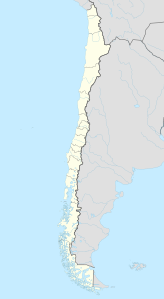Juncal (mountain)
| Juncal | ||
|---|---|---|
|
The Nevado Juncal with the large Juncal North Glacier in the center (north side, in Chile), framed by the Nevado del Plomo (left, northeast side, in Argentina) and the El Plomo (right, in Chile). |
||
| height | 5953 m | |
| location | Chile / Argentina border | |
| Mountains | To the | |
| Dominance | 7.9 km → Nevado del Plomo | |
| Coordinates | 33 ° 2 ′ 40 ″ S , 70 ° 5 ′ 10 ″ W | |
|
|
||
| First ascent | January 17, 1911 by Federico Reichert , Robert Helbling and Damasio Beíza | |
The Juncal ( Spanish: Cerro Juncal or Nevado Juncal ) is, according to recent surveys, 5953 m high mountain on the border between the Chilean Región de Valparaíso and the Argentine province of Mendoza , a good 25 kilometers south of the Paso de la Cumbre border pass .
Location and surroundings
The Juncal massif forms a wall about two kilometers long just below the 6000 meter mark, which opens in a wide arc to the north. After the main summit in the north-east with a height of 5953 m follow in a clockwise direction
- the south summit ( location ) with 5910 m
- the Chilean summit (southwest summit, Spanish Cumbre Chilena , location ), which reaches the main summit with a height of 5953 m , and
- Columna (also Nevado de los Leones , north-west summit , location ) with 5660 m .
The lowest point between the main peak and the Chilean peak is still 5821 m .
In front of the massif to the northwest is the striking Alto de los Leones ( 5380 m , location ).
The Juncal massif is heavily glaciated. Clockwise, starting from the east, the following glaciers cover the massif:
- Glaciar Juncal Segundo Este and
- Glaciar Juncal Primero Este , both of which drain into the Río Plomo ,
- Glaciar Juncal Sur , which is the longest glacier of the massif with an approximate length of 15 km and drains into the Río Olivares ,
- Glaciar Los Leones in the northwest,
- Glaciar Juncal Norte , which drains into the valley of the Río Juncal and
- Glaciar Juncal Colgante Norte , which flows north into the Valle Monos de Agua .
The mountain is located on the Chilean side in Parque Andino Juncal , which has been protected as a wetland according to the Ramsar Convention since May 22, 2010 . A large park under provincial administration immediately follows on the Argentine side.
height
Until recently (around 2010) the mountain was given an altitude of 6110 m . This height goes back to Robert Helbling, who carried out the first measurements of the massif between 1908 and 1918 and which was confirmed in 1956 by Louis Lliboutry and his description of the central Andes. However, Lliboutry's altitude information is considered to be imprecise, deviations of 500 meters from the current official maps are not uncommon. In addition, the summit region of the Juncal is difficult to access for triangulation , and this area therefore remained unlisted on the official maps for a long time. Today the Chilean IGM gives an altitude of 5953 m , the Argentine IGN an altitude of 5965 m .
history
Surname
The Spanish word Juncal means rush plant . The valley north of the Juncal is traversed by the Río Juncal and has been placed under protection for its flora.
First ascent
The first ascent took place on January 17, 1911 by the German-Argentine Federico Reichert and the Swiss Robert Helbling with the Chilean Damasio Beíza , who climbed the summit from the Argentine east side through the valley of the Río Plomo, over the Glaciar Juncal Segundo Este (second eastern Juncal Glacier) and finally reached via the north ridge.
The second ascent took place on March 3, 1934 by the Italians Gabriele Boccalatte and Piero Zanetti from the north over the Glaciar Juncal Norte . The third ascent in 1951 by an expedition of the DAV Santiago over the Glaciar Juncal Colgante Norte from the Valle Monos de Agua , again from the north.
Web links
- Juncal on andeshandbook.com (Spanish)
- Ulrich Lorber: Nevado Juncal. (PDF; 7.3 MB) Monografia de una Montana. October 30, 2005, accessed October 24, 2010 (Spanish, with many photos and maps).
- A. Schellenberger: Dr. Robert Helbling - between Aconcagua and Tupungato. (PDF; 1.7 MB) Geographical Institute of the University of Bern, accessed on October 24, 2010 (with a detailed map of the east side of the Juncal (around 1911)).
- Parque Andino Juncal website. Retrieved October 24, 2010 (Spanish).
- Juncal (mountain) on Peakbagger.com (English)
Individual evidence
- ↑ according to IGM , quoted from Ulrich Lorber
- ^ Parque Andino Juncal. Retrieved October 24, 2010 .
- ↑ Evelio Echeverría: Un Arriero Andinista en 1910. (Not available online.) 1963, formerly in the original ; Retrieved October 26, 2010 (Spanish). ( Page no longer available , search in web archives ) Info: The link was automatically marked as defective. Please check the link according to the instructions and then remove this notice.

